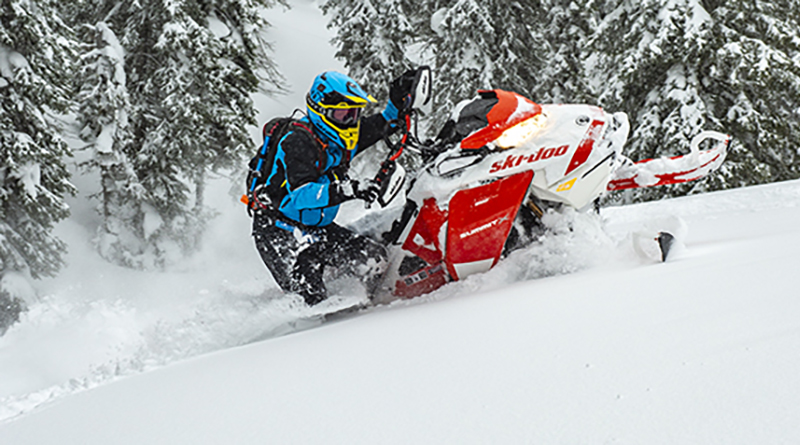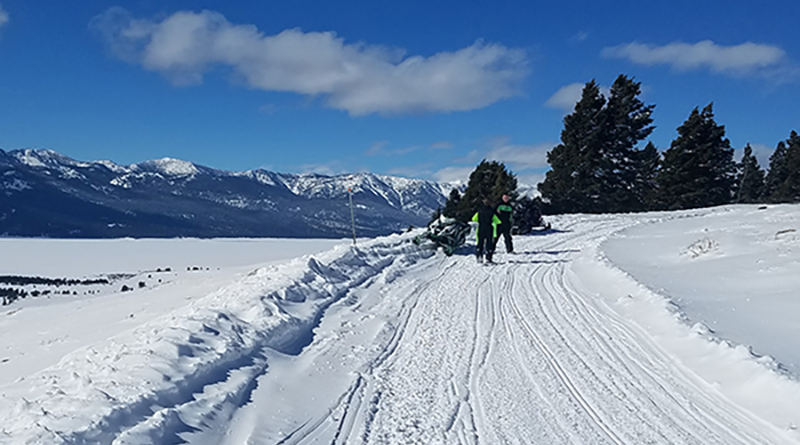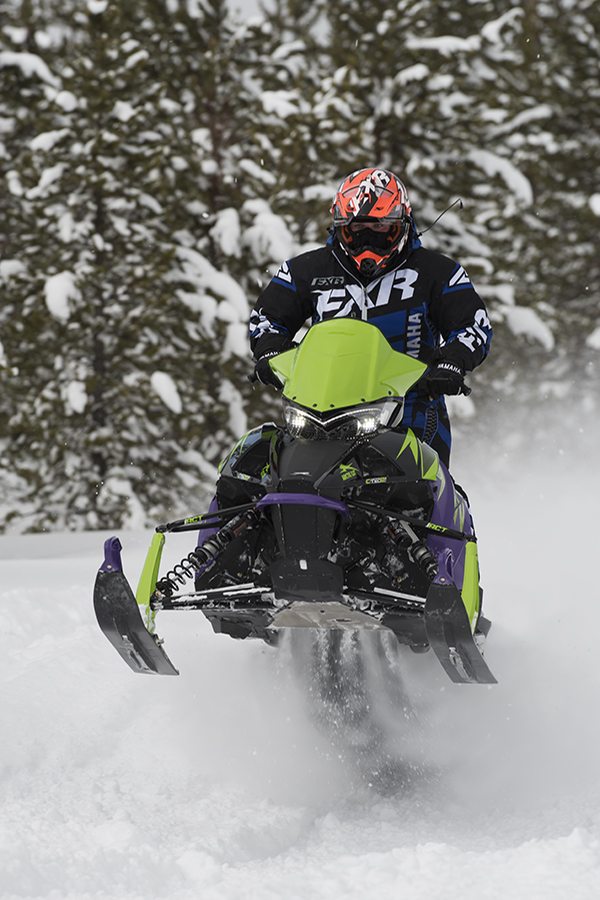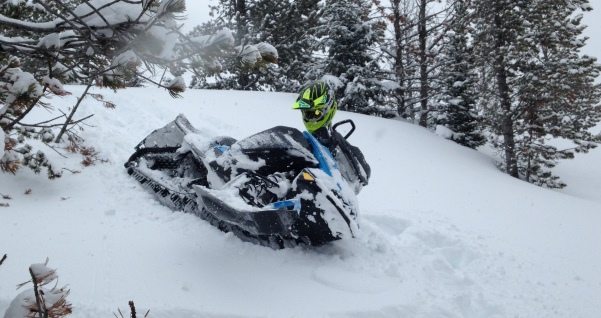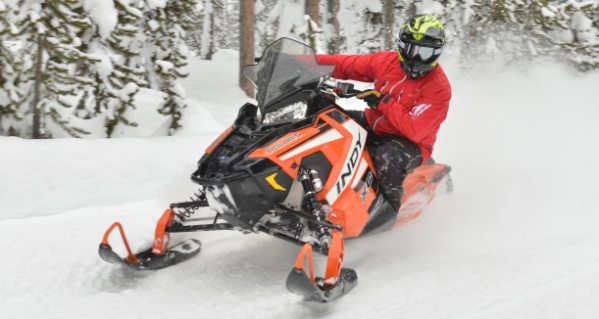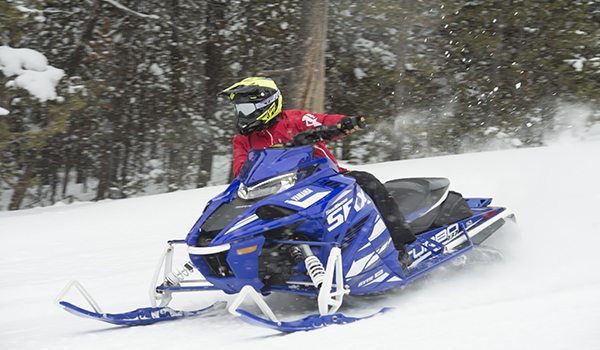There’s been a quiet revolution in the world of low-cost snowmobiles. Machines that, even five years ago, could be associated with “low power,” “sketchy quality,” “rattletrap” and “downright ugly” are now machines that a buyer of any age — or even ability — could proudly own. Displacements are up, quality seems higher and the level of technology has increased.
We tried out several budget snowmobiles at the 2009 Rode Reports, including the F570 and F5 from Arctic Cat, the Polaris 550 IQ Shift and the Yamaha Phazer RTX for some head-to-head fun. The comparable Ski-Doo MX Z 550 X was not available for testing.
Aim high, but look low as a new day dawns for entry-level snowmobiles.
Arctic Cat F570
Price: $6,499
 Weight: N/A
Weight: N/A
Engine: 565cc two-stroke fan
Horsepower: 60 hp
Front Suspension: AWS VII double wishbone A-arms, hydraulic twin tube shocks, 9.5 inches of travel
Rear Suspension: Slide-action skidframe with adjustable torsion springs, hydraulic twin-tube shocks, 13.5 inches of travel
Fuel Capacity: 10.8 gallons
Cost-Cutting Measures: Same suspensions as bigger-displacement F machines, but with basic twin-tube shocks
Bonus features: Electric start, digital/analog tach and speedo, electric gas gauge, mechanical reverse
It’s not the look that gives the F570 away as an entry-level sled. It’s the sound. The whooshing whir of the fan-cooled engine tells its secret.

This machine is one of the lowest-displacement full-sized snowmobiles in the Arctic Cat lineup: the others, the T 570 and the Bearcat 570, use the same engine.
The F570 came into the Cat lineup in 2008 as an upgrade to the Z 570. It’s the same engine, but now in the Twin-Spar chassis. The machine got a spit-shine for 2009; not much changed from the 2008 model other than graphics and some mounting positions.
One look at the specs and it’s easy to see that the 570 mill is tied for the lowest of the tested machines in terms of power, but the Twin Spar is a heavier chassis. We kept the throttle at the bar for good portions of our ride. The good news is that the engine is easy to control and there’s nothing unpredictable about it. It won’t satisfy a true need for speed, but can settle into a comfortable pace. Parents who want a built-in speed governor for the kids may also like this option.
Handling on the F570 is unusually soft. We’ve come to expect a floating feeling from Arctic Cats and while it’s less cushy than the previous Z model, it’s still not tight. Handling isn’t always predictable. It’s easy to move it around, but it’s definitely more “sedan” than “sports car.” In sweeping turns, there was some push and squirrely behavior.
But lets get serious: how does it work when the trail gets rough? This machine’s forte is the rear suspension reaction to stutter bumps. There was a bit of feedback through the handlebars, but it tracked well and was easy to correct. The larger the bumps, the more the performance decreased. It’s obvious that the suspension is tuned for relatively smaller bumps and for repetitive hits, not G-bumps.

Overall, this machine is a solid “OK.” It feels somewhat clumsy next to the Shift model — almost as if it already needs an update. The stereo-typical hard driving Cat rider would be disappointed in this machine, but it makes a good starter sled for the more moderate driver. And when the moderate driver hits the stutter bumps driver and sled can wick it up.
Hits
+ Deluxe features (electric start, digital readouts, electric gas gauge, Hack Saw track) on entry machine
+ Stutter bump performance
+ Best-of-class handlebar setup
Misses
– Power-to-weight ratio makes it feel down on zip
– Large-bump performance
– Handling can be unpredictable
Polaris 550 IQ Shift
Price: $5,499
Weight: 470 pounds
Engine: 544cc two-stroke fan
 Horsepower: 60 hp
Horsepower: 60 hp
Front Suspension: IQ suspension, RydeFX MPV shocks, 10 inches of travel
Rear Suspension: IQ suspension, RydeFX MPV shocks, 13.9 inches of travel
Fuel Capacity: 11.5 gallons
Cost-Cutting Measures: No graphics, mechanical fuel gauge, no tachometer
Bonus Features: Hand and thumb warmers, PERC reverse
The Polaris entry-level machine got its well-deserved update for this year. Instead of producing another amalgamation of spare partslike it did with the Super Sport last year, Polaris put together a sled that could be a class leader. It’s a true tale of worst to first.
Polaris expanded its no-frills Shift line to six models this year, including a fan-cooled entry. It replaces the Super Sport, a machine that had its day, but was ready to go. The 550 IQ Shift is the entry-level snowmobile that Polaris buyers deserve, and then some.
While the machine is not fancy, it’s not bare bones. Engineers weigh the cost-versus-value aspect with each feature on the machine. The results include an absence of graphics and a basic gauge, but the inclusion of a lightweight freestyle seat and brand-name shocks. The concept is that drivers will personalize the sled. For example, we’d add hooked handlebars. Side note: these, and other Shifts, do have thumb warmers this year.
The 550 IQ Shift took the best aspect of its predecessor: the 544cc fan-cooled engine. The engine has “oldie but goodie” status, as it’s been nearly unchanged since 1999. It has the same horsepower output as the Arctic Cat F570, but it feels faster and lighter. It has the spunk that was missing from the Cat.
The 550 IQ Shift’s handling, at any speed, was the most predictable in the test. There was no darting, no sudden twitches. There was some ski lift if driving hard into corners, but it was a manageable, predictable occurrence. It gave real confidence to a variety of riders and riding styles, and was the most stable in the grouping.
As for rough trails, the Shift got better as the trail worsened. The nastier and larger the bumps, the better the performance. In stutter bumps, the front suspension performed well but the rear felt downright harsh. The setting was “medium,” which should be about right for our testers. However, the back bounced through the chop while the front breezed through.
There were shortcomings on this machine, but was hands-down the favorite of the grouping. Several testers noted this as the “must buy” for this class. It was sportiest of the lot, and the one everyone wanted to ride for a second and third time. Buyers of this machine will be pleased, especially at this price point.
Hits
+ Handles well at any speed
+ Quality performance from engine
+ Top score for fun factor
Misses
– Harsh rear suspension
– Consider handlebar hooks for aggressive riding
– The hard, narrow seat wasn’t always comfortable
Yamaha Phazer RTX
Price: $7,699
Weight: 489 pounds
Engine: 499cc four-stroke liquid
Horsepower: 80 hp
Front Suspension: Independent double wishbone, Fox
FLOAT shocks, 9.3 inches of travel
Rear Suspension: Dual shock CK; C36 KYB aluminum HPG (front shock); C36 KYB aluminum HPG clicker (rear shock); 16.2 inches of travel
Fuel Capacity: 7 gallons
Cost-Cutting Measures: Tiny windshield
Bonus Features: Four-stroke engine, Fox FLOAT shocks
During the 440 craze, the joke at Yamaha was that the code for the R&D room was “No. 440.” After all, it had the Phazer as its entry-level anchor. Then, in the early 2000s, the Phazer disappeared and Yamaha buyers had to pony up for larger-displacement machines.
Three years ago, the Phazer made its comeback. Always a trend-setting machine, it returned with radical styling and a throaty low-cc four-stroke engine. The Phazer is again the machine at the entry-level end of Yamaha’s spectrum, though it’s hard to directly compare it to the performance of a fan-cooled machine. We tested the RTX — the machine Yamaha places in its “rough trail” category, but there are two other Phazers: a groomed trail (GT) model for $7,499 and a basic Phazer package for $6,699.
The Phazer houses a 499cc, 80 hp four-stroke engine. It has a good braaap going for it, and is sensitive to any throttle adjustment. The motor has tons of torque compared to the others in the test and the exhaust sounds the sportiest with its aggressive bark.
The Phazer is an interesting concept, with its high center of gravity and dirtbike-meets-ATV-meets-snowmobile feel. This also translates into confused handling for the machine. The parts are all there, but they don’t seem to work well together. The tight, twisty trails were this machine’s nemesis, with inside ski lift that keeps the driver guessing. We had to pay close attention to corner speed because the front end would tweak, which caused the ski to pop up while the back end tried to pass the front.
Then again, this machine has the RTX designation. We found the handling improved as the trails roughed up. The suspensions should perform well — they use premium shocks — however the performance was a mixed bag. The front and rear were choppy in the stutter bumps, which caused the sled to wander. In a series of off-trail bumps, the front end felt disconnected as if it needed more sway bar. But then, on some really rough trails, the suspensions seemed to do their job — or had we gotten used to it?
We really wanted to like this machine. It has cool engineering, is radical in its design and uses high-end parts. However, the handling issues were too much for us to overlook. This machine is for the rider who wants it for its potential, and is willing to put in the sweat equity and cash to the aftermarket to get its suspensions and handling set-up right.
Hits
+ The torque and sound of the engine
+ Premium shock package
+ Fit and finish is flawless
Misses
– Priced way higher than other entry-level machines
– Prefers premium gas
– Unpredictable handling
Also Consider: The Arctic Cat F5
We took a fourth machine on our test ride: something that was perhaps a bit more comparable to the Phazer RTX.
Style-wise, the F5 is nearly identical to the F570: it’s the same chassis, the same look and comparable features. Side-by-side, many specs are identical. The front and rear suspensions use the same geometry and shocks. The main difference is the use of coupler blocks in the F5’s rear setup.
The F5 uses a 499cc, liquid-cooled two-stroke twin with 80 hp, which puts it in line with the Phazer mill. At $7,499, it’s just $200 less than the RTX. They also seem to be targeted at the same type of driver: one who fancies themselves sporty, edgy and likely a bit cocky.
Overall, this machine was close in performance to the F570. The F5 seemed to have the “whatever you can do, I can do better” attitude over the F570 — and it ups the ante, if only slightly, in every category over the fan. The handling is tighter, the engine is stronger, the handlebar feedback is less and the suspensions take the rough better. It’s up to the buyer to determine if it’s worth an extra $1,000 over the F570, or a savings compared to the Phazer RTX.
Rankings
Off-trail Bumps:
1. Polaris 550 IQ Shift
2. Arctic Cat F570
3. Yamaha Phazer RTX
Sweepers:
1. Polaris 550 IQ Shift
2. Arctic Cat F570
3. Yamaha Phazer RTX
Stutter Bumps:
1. Arctic Cat F570
2. Polaris 550 IQ Shift
3. Yamaha Phazer RTX
Engine Power:
1. Yamaha Phazer RTX
2. Polaris 550 IQ Shift
3. Arctic Cat F570
Sleds for less than $7,000
$5,249 Ski-Doo Tundra 300 Fan
$5,449 Ski-Doo Freestyle Backcountry
$5,499 Polaris 550 IQ Shift
$5,999 Polaris Trail RMK
$6,299 Ski-Doo Summit Fan
$6,349 Ski-Doo GSX 550 Fan
$6,499 Arctic Cat F570
$6,599 Polaris Trail Touring Dlx.; Polaris 550 Transport; Ski-Doo MX Z 550 X
$6,699 Ski-Doo GTX 550 Fan
$6,799 Arctic Cat Bearcat 570
$6,699 Yamaha Phazer
$6,999 Polaris 600 IQ Shift

